Click on images to enlarge
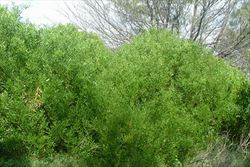
infestation (Photo: Sheldon Navie)
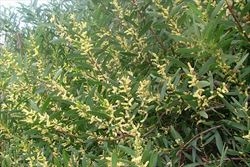
habit in flower (Photo: Sheldon Navie)
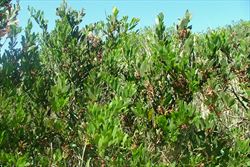
habit in fruit (Photo: Sheldon Navie)
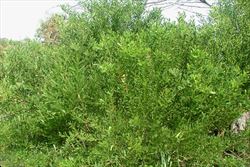
upright habit of plants growing in a hind-dune area (Photo: Sheldon Navie)
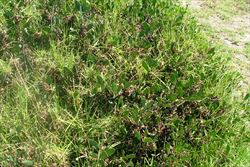
low-growing habit of plant growing on an exposed fore-dune (Photo: Sheldon Navie)
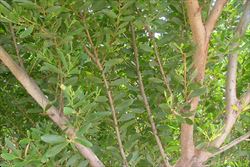
older branches with relatively smooth greyish-coloured bark (Photo: Sheldon Navie)
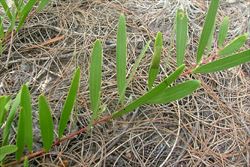
creping branch, which may produce adventitious roots (Photo: Sheldon Navie)

large, smooth, galls caused by a species of wasp (Photo: Greg Jordan)
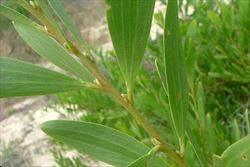
younger branches are greenish in colour and somewhat angled (Photo: Sheldon Navie)
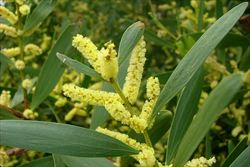
elongated flower clusters (Photo: Sheldon Navie)
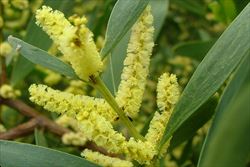
close-up of the fluffy yellow flowers, each with numerous stamens (Photo: Sheldon Navie)
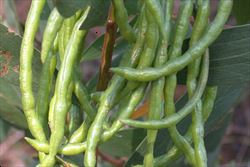
immature fruit, which are cylindrical and slightly curved (Photo: Greg Jordan)
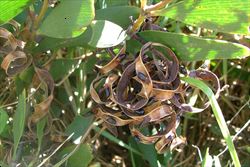
the fruit become very coiled and twisted when mature (Photo: Sheldon Navie)
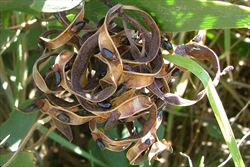
the shiny black seeds have a fleshy structure attached to them (Photo: Sheldon Navie)
Scientific Name
Acacia longifolia (Andrews) Willd. subsp. sophorae (Labill.) Court
Note: Acacia sophorae (Labill.) R. Br. is currently used in Queensland.
Synonyms
Acacia longifolia (Andrews) Willd. forma sophorae (Labill.) Siebert & Voss
Acacia longifolia (Andrews) Willd. var. prostrata C. Moore & Betche
Acacia longifolia (Andrews) Willd. var. sophorae (Labill.) Benth.
Acacia longifolia (Andrews) Willd. var. sophorae (Labill.) F. Muell.
Acacia sophorae (Labill.) R. Br.
Acacia sophorae (Labill.) R. Br. var. sophorae
Cuparilla sophorae (Labill.) Raf.
Cuparilla sophorina Raf., orth. var.
Mimosa sophorae Labill.
Phyllodoce sophora Link
Racosperma sophora (Labill.) Mart., orth. var.
Racosperma sophorae (Labill.) Mart.
Family
Fabaceae: sub-family Mimosoideae (New South Wales)
Leguminosae (South Australia)
Mimosaceae (Queensland, the ACT, Victoria, Tasmania, Western Australia and the Northern Territory)
Common Names
boobyalla, coast wattle, coastal wattle, false boobyalla, sallow wattle
Origin
Native to the coastal districts of much of eastern and southern Australia (i.e. south-eastern Queensland, eastern New South Wales, Victoria, Tasmania and south-eastern South Australia). In South Australia it occurs naturally in coastal districts from the southern parts of the Eyre Peninsula eastwards. In Victoria, New South Wales and Tasmania it is widespread and found in all coastal districts of these states. In Queensland it is only present in the south-eastern parts of the state, from the border north to the mouth of the Maroochy River.
Cultivation
Coastal wattle (Acacia longifolia subsp. sophorae) has been widely planted in southern and eastern Australia, particularly in areas with sandy soils. It has been grown as a garden ornamental and has also been deliberately planted as a sand-binder.
Naturalised Distribution
Naturalised in the coastal districts of south-western Western Australia, between Perth and Albany. It is regarded to be naturalised beyond its native range in the inland districts of Victoria and south-eastern South Australia, and on the southern tablelands of New South Wales. It is also spreading into local environments and plant communities within the coastal districts of these three states which it did not previously occupy (i.e. it is naturalising in areas within its geographic native range that are beyond its presumed ecological range).
Habitat
Grows naturally only in coastal districts and relatively close to the sea, where it is a pioneer species that often colonises coastal sand dunes. It prefers habitats such as coastal sand dunes, headlands, and adjacent alluvial flats. It is also less commonly found in nearby coastal heath and sclerophyll forests. Where both plants are present, Sydney golden wattle (Acacia longifolia subsp. longifolia) usually occurs more towards the hinterlands of coastal districts and is generally replaced by coastal wattle (Acacia longifolia subsp. sophorae) nearer to the sea. However, in some localities the two sub-species appear to grade almost imperceptively into one another.
In areas where it has become naturalised beyond its native range, coastal wattle (Acacia longifolia subsp. sophorae) may grow in similar coastal sites. It may also invade grasslands, heathlands, open woodlands and forests in sub-coastal or inland areas, particularly those that have been disturbed. In Western Australia it grows along roadsides, along watercourses, and in swamps.
Habit
A low-growing (i.e. prostrate, decumbent or ascending) shrub usually growing 0.5-3 m tall, but occasionally reaching up to 5 m in height. It has a very spreading habit and individual plants can cover an area 10-15 m wide. Plants growing in more exposed locations that are closer to the sea (e.g. on foredunes) tend to be more low-growing than those found further from the sea (e.g. on hinddunes).
Distinguishing Features
- a shrub or small tree with simple 'leaves' that are green or yellowish-green in colour.
- its 'leaves' are elongated to elliptic in shape (less than five times longer than wide) and narrow abruptly to a rounded or somewhat pointed tip.
- its yellow or golden-yellow flowers are densely arranged in elongated clusters (25-50 mm long), one or two of which are borne in each 'leaf' fork.
- its elongated and cylindrical pods (4-15 cm long) that are curved or coiled and slightly constricted between each of the seeds.
Seedling
Stems and Leaves
The bark on older stems is greyish in colour and either smooth or finely fissured. Younger branches are green or reddish-green in colour and angled towards their tips. These branches are either hairless (i.e. glabrous) or sparsely covered in close-lying (i.e. appressed) hairs.
The 'leaves' of this plant are actually flattened and widened leaf stalks (i.e. petioles), and not leaves in the true sense of the word. These modified leaf stalks are called phyllodes, but serve the same function as a regular leaf. On very young plants, partially formed phyllodes can be seen which bear compound (i.e. bipinnate) leaves at their tips. As the seedling grows, each new 'leaf' has phyllodes that are more fully formed and the leaves at their tips become reduced and eventually vanish altogether. The phyllodes are alternately arranged along the stems, somewhat elongated to elliptic in shape (4-12 cm long and 10-35 mm wide), and generally less than five times longer than they are broad. They are straight or occasionally slightly curved, mostly hairless (i.e. glabrous), and green or yellowish green in colour. They are also relatively thick and leathery (occasionally even slightly fleshy) and have rounded tips (i.e. obtuse apices), occasionally with a tiny point (i.e. sometimes mucronate). There are 2-5 prominent parallel veins that run the length of each of the phyllodes, and where each phyllode joins to the stem there is a short thickened structure (i.e. pulvinus) about 3 mm long which can be easily confused for a leaf stalk (i.e. petiole). Near the base of the phyllode (2-5 mm above the pulvinus), there is a usually a small indentation or raised structure (i.e. gland) on the phyllode margin.
Flowers and Fruit
The small yellow or golden-yellow flowers are stalkless (i.e. sessile) and densely arranged in elongated clusters (20-50 mm long and about 7 mm wide). These flowers each have four relatively inconspicuous petals and sepals and numerous conspicuous stamens that give them a very fluffy appearance.The elongated flower clusters (i.e. spikes) are stalkless or have very short stalks that are less than 2 mm long (i.e. they are sessile or sub-sessile). These flower clusters emanate from the forks (i.e. axils) of the upper leaves and one or two may be present in each leaf fork. Flowering occurs mainly during winter and early spring (i.e. from July to October).
The fruit is a very elongated pod (40-150 mm long and 3-10 mm wide) that is cylindrical or almost cylindrical in shape and often has a long pointed tip. These pods are sometimes constricted between each of the seeds and are either hairless or sparsely hairy (i.e. glabrous or puberulent). They are usually somewhat curved or coiled and become are twisted and contorted on opening. The pods are initially green in colour but turn brown as they mature and are normally present during late spring and summer (i.e. from November to January). Each pod cotains 4-10 black seeds thatare oval (i.e. elliptic) in shape. These seeds (5-6 mm long and 3-4 mm wide) are smooth in texture and shiny in appearance. They have a large, orange, fleshy, cup-shaped structure (i.e. aril) attached to them.
Reproduction and Dispersal
Reproduction in this species is mainly by seed. However, the spreading branches (up to 9 m long) typically rest on the ground and give rise to adventitious roots, which can develop into separate plants (i.e. it can reproduce by layering). Young plants also often reshoot vigorously from their bases after fire or other forms of damage.
Seeds may be dispersed by animals such as ants, birds, reptiles and rabbits. For example, large flocks of introduced common starlings have been observed to eat the seeds and deposit them under nearby powerlines. Seeds may also be spread by human activities (e.g. during the slashing of roadsides, on moving vehicles, in dumped garden waste, and in contaminated soil).
Environmental Impact
In Victoria and South Australia, this species has become a serious environmental weed of near-coastal heaths and woodlands. In particular, it is now regarded as a very serious environmental weed in southern Victoria. It has also recently been identified as a problem in the coastal grasslands of south-eastern New South Wales and is listed as an environmental weed for the wider Sydney and Blue Mountains region.
Coastal wattle (Acacia longifolia subsp. sophorae) has been widely planted away from the coast and in coastal areas beyond its native range (e.g. in south-western Western Australia). In such areas it readily invades nearby bushland habitats including heathlands, open woodlands and forests. However, coastal wattle (Acacia longifolia subsp. sophorae) is also a very serious problem within its geographic native range, where it has become seriously invasive in the last two decades. It has invaded habitats where it was previously absent, and in some areas this invasion has been clearly demonstrated by observation of aerial photographic records taken over the last sixty years.
This species is having a profound effect on the coastal heath vegetation in south-western Victoria, where it is now thought to infest an estimated 10 000 hectacres of indigenous vegetation. Many coastal communities near Portland in south-western Victoria have changed dramatically and suffered a serious loss of plant diversity as they have become dominated by this species. In fact it threatens the destruction of most of the coastal heathland and woodland vegetation in this area, as well as populations of rare plant and animal species. For example, the endangered Mellblom's spider orchid (Caladenia hastata) and the endangered heath rat (Pseudomys shortrigdei) are both thought to be under threat. Its invasion of the Bats Ridge Wildlife Reserve, also in south-western Victoria, is threatening the remaining populations of the spider orchid known as limestone caladenia (Caladenia calcicola). It has also been shown to reduce the diversity of the ant population in infested areas.
Coastal wattle (Acacia longifolia subsp. sophorae) has also taken over large areas of Balcombe Park Reserve, near Melbourne in southern Victoria. At the height of its invasion in this area it was one of the most dominant woody weeds present, and had largely shaded out the original species present in this heathland area. Better management of this area, including the use of controlled ecological burns, has led to the regeneration of the heathland and an increase in species diversity.
Similar problems are also being observed in south-eastern New South Wales, where a dense infestation of this species is replacing the native grasslands in the Eurobodalla National Park. A significant proportion of a large study area in this park was found to be invaded by this species, and there was a strong correlation between its presence and a decline in the number of plant species present. Only a small number of shade-tolerant native plants were found to survive in densly infested areas, and the threatened semi-parasitic herb austral toadflax (Thesium australe) did not grow where coastal wattle (Acacia longifolia subsp. sophorae) was present.
In studies conducted in Victoria and New South Wales it has been found that the change is progressive, and that areas that had been invaded for a longer period of time were more greatly affected. Dense infestations could often cause up to 75% of indigenous species to be lost from the vegetation, and at worst all indigenous species may be eliminated.
The recent invasiveness of this species within its native range it thought to have two main causes. Firstly, fires occur much less frequently in these areas than they used to. A situation which has been brought about by recent fire supression policies. Also, increased bird dispersal of seed may be another factor. Large flocks of common starlings, an introduced pest bird species, have been seen to nest where coastal wattle (Acacia longifolia subsp. sophorae) grows naturally. These birds have also been observed to readily feast on its seeds, presumably for the fleshy arils which are attached to them. They may then disperse the seeds intact to areas beyond the natural range of this species (e.g. by depositing them under trees and powerlines some distance away).
Legislation
Coastal wattle (Acacia longifolia subsp. sophorae) is not declared or considered noxious by any state or territory government in Australia.
Management
For information on the management of this species see the following resources:
- the Woody Weeds Information Pamphlet on the Environmental Weeds Action Network (EWAN) website at http://members.iinet.net.au/~ewan/.
Similar Species
Coastal wattle (Acacia longifolia subsp. sophorae) is very similar to Sydney golden wattle (Acacia longifolia subsp. longifolia). Typical individuals of these two plants can be distinguished by the following differences:
- coastal wattle (Acacia longifolia subsp. sophorae) is a low-growing shrub usually 0.5-3 m tall. Its 'leaves' (i.e. phyllodes) are relatively short and broad (4-12 cm long and 10-35 mm wide) and usually less than five times longer than they are wide. These 'leaves' are usually relatively thick and leathery in nature and narrow abruptly to rounded or somewhat pointed tips (i.e. obtuse or slightly mucronate apices). The pods are curved or coiled when young and become very contorted or twisted after opening.
- Sydney golden wattle (Acacia longifolia subsp. longifolia) is a more upright shrub growing up to 10 m tall. Its 'leaves (i.e. phyllodes) are relatively long and narrow (5-25 cm long and 4-20 mm wide) and usually more than six times longer than they are wide. These 'leaves' are usually relatively thin and pliable in nature and narrow gradually to pointed or somewhat pointed tips (i.e. acute or sub-acute apices). The pods are straight or slightly curved when young , but may become curled back or slightly twisted after opening.
Note: Hybrids of coastal wattle (Acacia longifolia subsp. sophorae) and Sydney golden wattle (Acacia longifolia subsp. longifolia) are thought to occur naturally where the two plants grow together. Such hybrid plants display characters that are intermediate between the two parent plants. Therefore, this can often make it difficult to determine whether particular specimens are Sydney golden wattle (Acacia longifolia susbp. longifolia), coastal wattle (Acacia longifolia subsp. sophorae), or an intermediate hybrid of the two.
Coastal wattle (Acacia longifolia subsp. sophorae) is also very similar to stiff-leaf wattle (Acacia obtusifolia) and forms a natural hybrid with spike wattle (Acacia oxycedrus) in some parts of the country. Stiff-leaved wattle (Acacia obtusifolia) can be differentiated by its longer leaves (12-25 cm long and 7-23 mm wide) and that fact that it flowers during late spring and summer (i.e. from November to January). Acacia oxycedrus x Acacia longifolia subsp. sophorae has somewhat hairy stems and its 'leaves' (i.e. phyllodes) are quite rigid in nature with sharply to coarsely pointed tips (i.e. pungent apices).
This page only covers those species that have been reported to be commonly confused with coastal wattle (Acacia longifolia subsp. sophorae). For a more in-depth key to all of (Acacia spp.) present in Australia, see the Wattle: Acacias of Australia CD-ROM or Flora of Australia, Volumes 11A and 11B.

